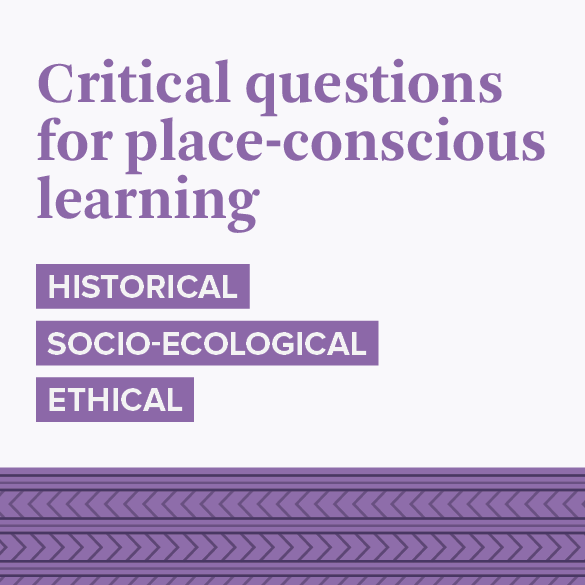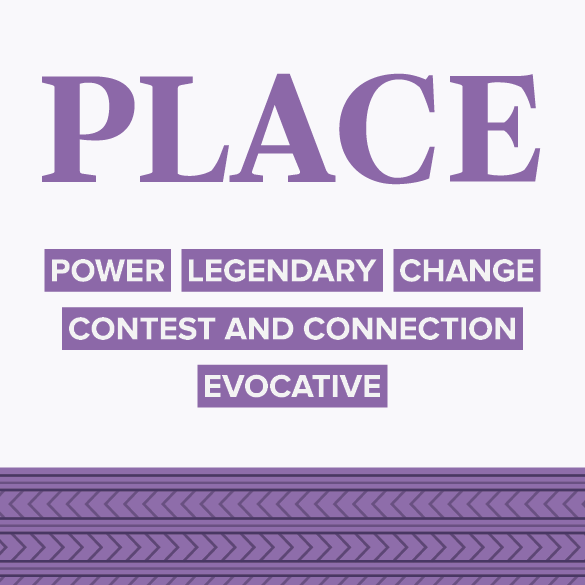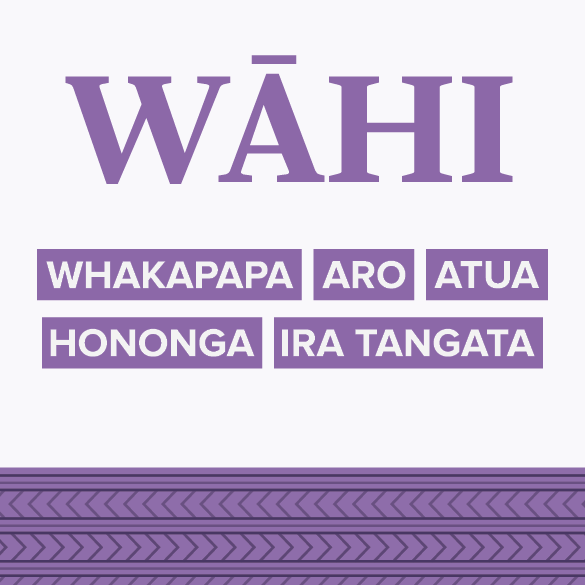Using this page
This page provides a summary of place-based education and why it is important. It offers a framework and questions that teachers can use when undertaking place-based education. The approaches presented here serve as prompts for teachers to wānanga (meet and discuss), adapt and improve.
Curriculum
This page supports an integrated approach to teaching the big ideas of Aotearoa New Zealand histories – Understand | Know | Do.
Aotearoa New Zealand's Histories – Ministry of Education (PDF, 508KB)
Key concepts
Important concepts linked to place-based education include:
- Whakapapa
- Belonging
- Whenua
- Tūrangawaewae
- Identity
- Remembrance
- Power.
What is place-based eductation?
Whatungarongaro te tangata, toitū te whenua.
People disappear, the land remains.
Māori proverb
Place-based education seeks to move us towards an understanding of and a connection with the places we inhabit. The relationship between people and place is rich and complex – places teach and shape people just as people shape places. Place-based education seeks to answer the questions: what is this place and what is our relationship with it?
Place-based education has the capacity] to develop in learners a love of their environment, of the place where they are living, of its social history, of the biodiversity that exists there, and of the way in which people have responded and continue to respond to the natural and social environments.
Professor Wally Penetito (Ngāti Hauā)
Whakapapa is at the heart of place-based learning – thinking about and through layers of time, people, stories, and objects. How are these layers woven into the present and future? What do people remember, and what can they recover? Histories – like Wellington’s awa (streams) – are covered up, silenced, or forgotten. The history of a place is like an onion: there are layers, some thicker and tougher than others. And when you slice history open, it can make you cry.
Place-based education – TKI Te Keti Ipurangi
Hidden streams field trip – Te Akomanga
The importance of place
Te toto o te tangata, he kai; te oranga o te tangata, he whenua.
The blood of people is from food, the sustenance/well-being of people derives from the land.
Māori proverb
Place-based education can be transformative. Learning the history of a place, in that place, where events happened and where people made their lives, can be an empowering and humbling act. Place-based education connects to ideas around belonging and identity – questions around who we are and where we are. What does this place mean to others? What do we mean to this place? How do we fit into this place?
Feeling out of place
How we inhabit a place can be the most telling expression of how we sense its worth, our intention for it and our connection with it.
Dr Geoff Park, ecologist
What about feeling out of place, disconnected from land and places? Wally Penetito comments that ‘Immigrants know … what it feels like to be out of place but no one experiences out of place more sharply than those who are colonised.’ Settler colonialism has created unsettlement. Place-based education provides specific contexts through which students can explore histories of colonisation, alienation, belonging and connection. As the waiata ‘E hara I te mea’ expresses in its melodies, ‘te whenua, te whenua, te oranga o te iwi’(from the land comes the well-being of the people). Place-based education is an approach to learning that can build understanding, connection, and well-being.
Make the familiar strange
We live in places, relate to others in them, die in them. Nothing we do is unplaced.
Professor Edward Casey, philosopher
All our experiences are ‘placed’. But because our lives are so ‘emplaced’ we can end up taking for granted the places we walk over and move through. The ordinary becomes invisible. One way to make the ordinary visible (or make the familiar strange) is by asking questions of it. This can lead to greater awareness and deeper engagement, something Elaine Enns and Ched Myers call Reinhabitation – learning to live ‘within’ a place, not just ‘on top’ of it.
Place-based education calls on high-context thinking. Asking questions about the names given to places is a good starting point. Most places or spaces have multiple ingoa (names) that can tell us about their physical characteristics (which may have changed over time), and about the people who settled there. By asking a wāhi (location) for its name or names, students can come to see place and space anthropomorphically, and experience wāhi as a living, breathing thing with a voice of its own.
Place names: survey pegs of the past – Te Akomanga
Learning questions and frameworks
Place-conscious learning: critical questions
Educator David Greenwood offers three broad questions to use when interrogating places.
For each question, he provides further questions to guide and support students undertaking place-based inquiries and actions.
Critical questions for place-conscious learning (PDF, 134KB)
Historical: what happened here?
- Who were the original inhabitants, both human and other-than-human?
- What are the indigenous stories of this place?
- What were – and what are – indigenous relationships with this place, and how have these relationships, and the place itself, changed or persisted over time?
Socio-ecological: what is happening here now, and in what direction is this place headed?
- What are the dominant stories attached to this place today?
- What stories are marginalised or silent here
- What is the voice of the land itself saying?
Ethical: what should happen here?
- What needs to be remembered?
- What needs to be recovered or restored?
- What needs to be conserved or maintained?
- What needs to be changed or transformed?
- What needs to be created?
Source: David A. Greenwood. A Critical Theory of Place-Conscious Education (2012)
PLACE: learning framework
Teacher Michael Harcourt and his students developed the PLACE framework for exploring and interrogating places.
To understand their significance, they look at how places like memorials have been impacted by the following criteria: Power, Legend, Change, Contest and connection, and Emotion.
PLACE learning framework (PDF, 121KB)
Power
- Is it a place which reveals power relations in society?
- Its meaning for people may have been silenced or marginalised in the past.
- People felt or continue to feel a sense of belonging there, while others feel excluded.
Legendary
- The place or monument is ‘storied’.
- People tell legends there and the place helps to sustain myths.
Change
- How has the place or memorial changed over time, whether physically or in terms of how it is used or viewed?
Contest and connection
- Was this place or monument argued over?
- Is it still a source of debate?
- People may feel a connection to it, often for varied reasons.
Evocative
- The place or monument is one where you can ‘feel’ history.
WĀHI: learning framework
The WĀHI framework supports the exploration of places and their histories through aspects of mātauranga Māori (Māori knowledge).
Students are encouraged to look at places in relation to Whakapapa, Aro, Atua, Hononga, and Ira tangata.
Please note that frameworks like these do not replace a unit of learning grounded in mātauranga Māori. Consideration and mana whenua input are always necessary, especially in relation to wāhi tapu (sacred place or site).
WĀHI learning framework (PDF, 123KB)
Whakapapa (layering of stories, genealogies)
- What is the genealogy of this place; who has connections here?
- Who are the mana whenua of this place; what is their kōrero?
- What names are given to this place?
- Think about past, present and future and how they are connected: what happened here; what is happening here now; what does the future hold for this place?
Aro (to pay attention to)
- What powerful stories and perspectives are shared in this place?
- What stories of aroha are linked to this place?
- What holds your attention in this place, and why?
Atua (ancestor)
- What ancestors continue to influence this place?
Hononga (connection, relation)
- What is the relationship between the built environment and the natural environment, and how have they changed?
- What relationships are remembered in this place and what silences exist?
- How does this place connect to other places nearby or far away?
- What have people done/still do that makes them connected or belong here?
- How do you connect with this place?
Ira tangata (human element)
- How have humans interacted and behaved in this place?
- How have humans changed the environment here?
- What do you think and feel when in this place?
- What do you want to learn more about here?
- Who are kaitiaki here?
Further information
Interrogating historic memorials and markers – Te Akomanga
Mana ōrite mō te Mātauranga Māori – Equal status for mātauranga Māori in NCEA – NCEA Education
Ricky Prebble, Educator–Historian




Community contributions